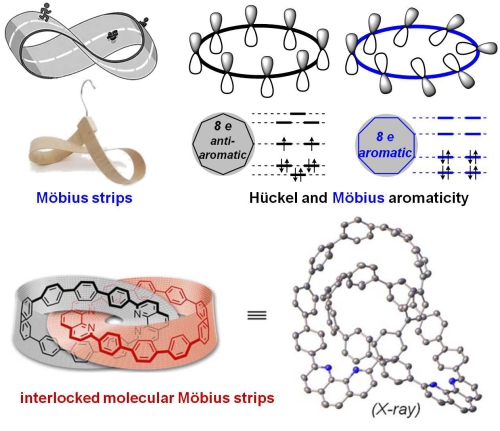Mobius strips (twisted, single-sided strip) display fascinating structures which are not only attractive in the field of topology, but also intriguing at the molecular level with unique aromaticity in complement to the conventional Hückel’s rule. However, synthesizing stable molecular Mobius strips remain a nontrivial task due to the complication of molecular strain and rotational flexibility. In this regard, building complex supermolecular structures based on Mobius-conjugated molecules presents an even more challenging goal.

Molecules exhibiting Mobius topology (Image by CONG Huan)
Recently, a collaborative research team from Technical Institute of Physics and Chemistry of Chinese Academy of Sciences and Xiamen University successfully prepared a catenane consisting of two fully conjugated nanohoops exhibiting Mobius topology in the solid state, using the copper-template method. In the context of molecular design, each monomeric nanohoop features a highly warped oligoparaphenylene chain with a phenanthroline moiety in order to reinforce molecular rigidity and facilitate catenane assembling.
The structure of the catenane molecule was unambiguously confirmed by X-ray crystallography, exhibiting a stabilized Mobius twisted π-system in the solid state. Theoretical calculation indicated that 84 kcal/mol intramolecular π-π interaction exists between the two nanohoop component within one catenane molecule, accounting for the highly stabilized Mobius conformation in the solid state. Electron delocalization and molecular aromaticity were also confirmed by theoretical calculation.
This work was published in Nature Communications (Nature Communications 2018, 9, 3037), showcasing a successful case for combining the power of synthetic and computational chemistry in the discovery and understanding of novel molecular architectures.
NEWS